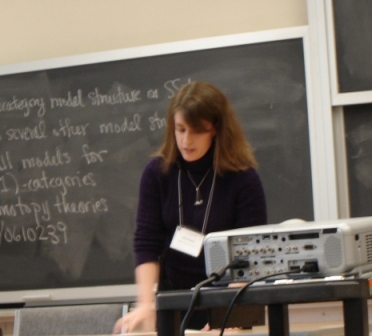New Hire at UCR
Posted by John Baez
Yay!
Julia Bergner has accepted a tenure-track position in the math department here at U. C. Riverside. She’s just finishing her third year as a postdoc at the University of Kansas. She’s done a lot of important work on the ‘homotopy theory of homotopy theories’.
So, life here at UCR just got a lot more interesting for people who like -categories.
What Julia Bergner wisely calls the ‘homotopy theory of homotopy theories’, I prefer to call the -category of -categories.
Quite roughly, an -category is an -category where all the -morphisms with are invertible. They’re a step in the direction of understanding fully general -categories, but they’re a lot easier to understand, in part because they’re related to topology.
It’s a wonderful fact, not yet fully understood, that -categories where all the -morphisms are weakly invertible are the same as topological spaces — at least as far as homotopy theory is concerned. So, you can think of an as an -category such that between any pair of objects we have a space of morphisms. Such things are incredibly common. The most famous is the category of topological spaces! Another is the category of chain complexes. Indeed, in any situation where we can do something like homotopy theory, there’s probably an -category lurking in the background. That’s why Julie wisely calls an -category a ‘homotopy theory’.
Julie has been studying ways to make these pretty words precise. There are at least as many ways to define -categories as to define -categories. In fact, right now there might be more! Here are a few:
- Topologically enriched categories. These are categories that have a topological space of morphisms between any two objects.
- Simplicially enriched categories. These are categories that have a simplicial set of morphisms between any two objects.
- Model categories. These are a standard framework for studying general ‘homotopy theories’. Any model category gives a simplicially enriched category using an old trick called the Dwyer–Kan simplicial localization.
- -categories. These are things like topologically or simplicially enriched categories, but where composition of morphisms is only associative ‘up to coherent homotopy’.
- Quasicategories. These are simplicial sets satisfying a weakened version of the ‘horn-filling condition’ that defines Kan complexes, which themselves describe -categories with all -morphisms invertible.
- Segal categories. A ‘Segal precategory’ is a simplicial space whose space of 0-simplices is discrete. A nice one of these is a Segal category.
- Complete Segal spaces. Your eyes are glazing over, so I won’t even attempt to explain these.
We need to relate all these concepts, to keep from going insane! But how?
How could we relate definitions of -category, for starters?
If Fred has his definition of -category, and Ned has his, how can we tell if their definitions are equivalent? We summon a neutral arbiter, say Ted, who has his own definition of -category. Ted must also have defined an -category of his -categories, say .
Then we set Ted to work! He must set up a Ted--category of Fred--categories, say . He also must set up a Ted--category of Ned--categories, .
Then,Ted needs to see if is equivalent to , viewed as objects in .
This is clearly a lot of work, and subject to various pitfalls. But, this is what Julia has successfully been doing — not for -categories, but for -categories!
She started by making the category of simplicially enriched categories into a model category. Like any model category, this gives a simplicially enriched category. So, there is a (large) simplicially enriched category of (small) simplicially enriched categories — the ‘homotopy theory of homotopy theories’.
Then, she obtained model categories starting from some other definitions of -category, and showed these were all ‘Quillen equivalent’. Joyal and Tierney have also been doing this sort of thing.
As a result, we now know there are simplicially enriched categories of ‘Segal categories’, ‘complete Segal spaces’, and ‘quasicategories’, all equivalent to the simplicially enriched category of simplicially enriched categories.
She gave a shockingly clear introduction to all this mind-boggling work at the Fields Institute last winter:

You can hear it and read the writeup here:
- Julia Bergner, A survey of -categories. Audio version: Model categories Quillen equivalent to the quasi-category model structure.
She’s also written lots of other interesting papers.
So, all UCR math grad students will soon be experts on -categories… and we’ll take over the world. ![]()

Re: New Hire at UCR
I thought I recognized that name. I saw her talk on “Thirteen ways of looking at a topological group” at the JMM last year in New Orleans. An excellent speaker.